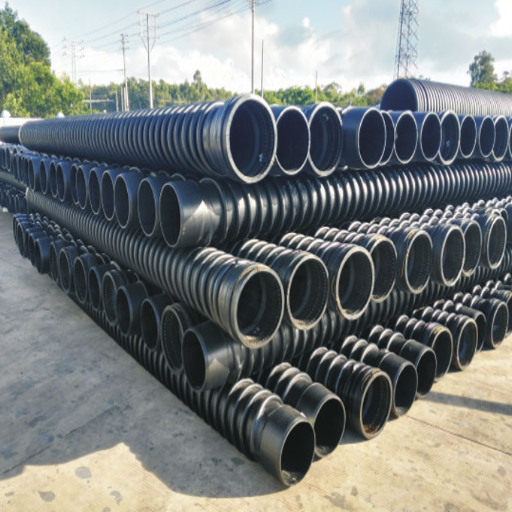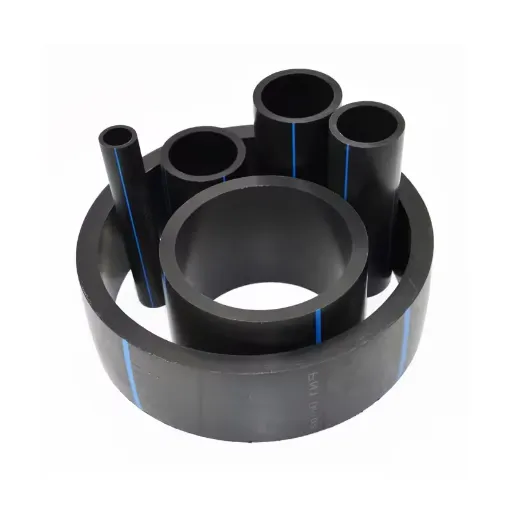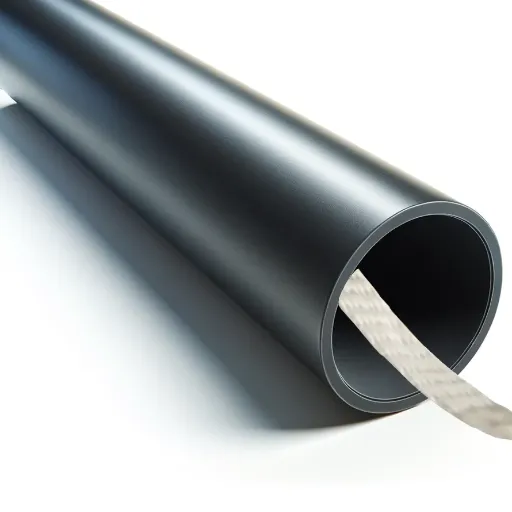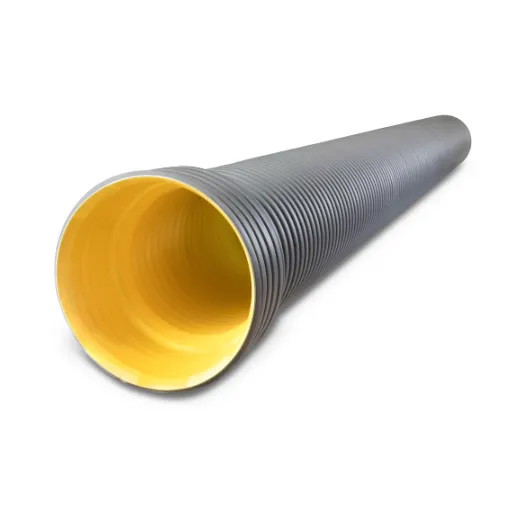High-density polyethylene (HDPE) double-wall pipe systems have emerged as a highly efficient and versatile solution in various infrastructure and drainage applications. Renowned for their durability, lightweight structure, and superior performance, these pipes have set a new standard for modern engineering and construction projects. This article aims to provide an in-depth exploration of HDPE double-wall pipe systems, discussing their key features, functional advantages, and diverse applications across industries. Whether used in urban drainage systems, agricultural irrigation, or industrial projects, these pipes deliver optimized performance while complying with stringent environmental and operational standards.
What is an HDPE Double Wall Pipe?
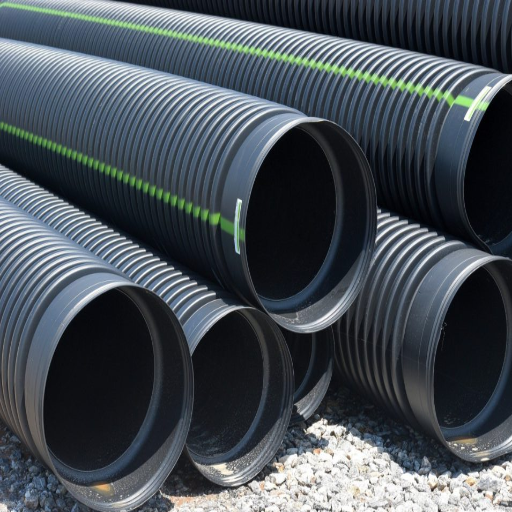
Understanding HDPE Material
High-Density Polyethylene (HDPE) is a tough, thermoplastic polymer manufactured from petroleum. It is recognized for its immense strength relative to its weight, flexibility, and resistance to chemicals making it suitable for a range of pipe systems including double-wall configurations. Structurally, HDPE is characterized by its dense molecular arrangement, which enhances its mechanical properties and durability.
- Density: Ranges between 0.93–0.97 g/cm³. This guarantees construction that is easy to lift and move, as well as flexible while still being strong enough to withstand mechanical forces.
- Tensile Strength: Approximately 21–37 MPa. This number supports high load-bearing capacities.
- Chemical Resistance: HDPE remains inert to acids, bases, solvents, and moisture which guarantees reliability in corrosive environments over time.
- Thermal Performance: Operating temperature typically ranges from -40°F to 140°F or -40°C to 60°C allowing use in different climates and industrial processes.
- UV Resistance (Optional): HDPE Compounds can be modified with stabilizers to resist aging from sun exposure.
Considering these factors, HDPE is an optimal choice for manufacturing pipes that have to endure mechanical, environmental, and chemical factors while providing excellent lifecycle performance.
Features of Double Wall Construction
Double wall constructions are more durable and strong while still maintaining a lightweight nature. An outer corrugated wall adds structural support while the inner wall is smooth to help with liquid flow. This setup helps with external load and also reduces system pressure losses.
- Load Capacity: The outer wall of the double structure is burly and suffers minimal compressive resistance. Because of this, the corrugated wall can be used in high-burden environments such as underground drainage systems.
- Flow Efficiency: The double wall structure boasts a smooth inner layer which diminishes fluid friction and allows for higher flow rates without sedimentation.
- Material Efficiency: The dual-layer structure provides a straddling weight while still maintaining robust mechanical performance.
These features paired with strong cost effectiveness make the double wall construction a great choice for applications expecting strength and efficiency.
Common Applications for HDPE Double Wall Piping
The remarkable strength-to-weight ratio, resistance to chemicals, and multifunctional adaptability of HDPE double wall piping systems make it a popular choice for numerous industries. Problems Stemmed from Urban and Industrial Waste are solved using such pipes:
- Stormwater Drainage Systems: SDD enjoys Pipes made of HDPE, polymer is durable and offers high flow efficiency while heavy mechanical abrasion encourages rough sediment water to be cleared without a second thought. such pipes endure under deep heavy loads without corrosion setting in.
- Sanitary Sewer Systems: Polyethylene pipes composed of HDPE are chemically stable thus making them ideal candidates for places filled with organic and corrosive materials waste. They also possess smooth insides ensuring a double guarantee against system blockages.
- Irrigation and Agricultural Drainage: The ability of polyethylene pipes made with HDPE to transport water over long distances while being exposed to UV and other external factors makes them ideal for large-scale irrigation projects.
- Industrial Waste Management: Unlike metal or concrete alternatives, these pipes are suitable for industrial effluents and tubular waste as they work efficiently around heavy machinery and enable effortless waste disposal.
- Road and Highway Drainage: Understanding the importance of long-term dependability in road and highway construction aided in the sharp focus of a needle on making such structures with slowly degradable materials. Thanks to HDPE, structural integrity is deeply enhanced while such piping encourages trouble-free usage for years to come.
These features guarantee optimal productivity in various environments thus making HDPE double-wall piping a dependable and economical choice.
Why Choose HDPE Double Wall Pipe for Your Project?
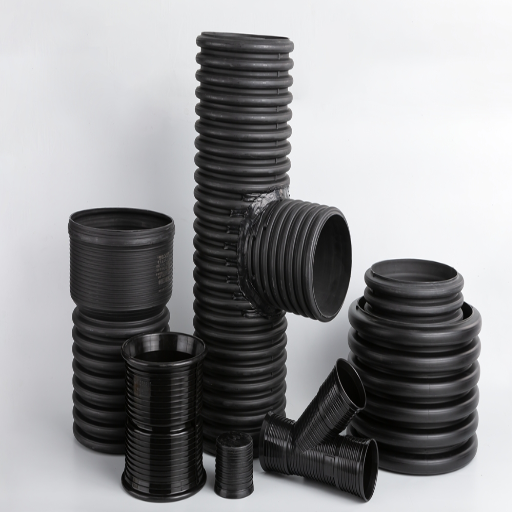
Advantages of HDPE Material
High-Density Polyethylene (HDPE) has many properties that make it suitable for piping applications. To begin with, its high level of chemical resistance has made it an excellent candidate for a variety of industrial applications. Its ability to endure harsh conditions posed by acids, bases, and salts makes it a crucial component in industrial and wastewater settings. In addition to that, HDPE is equally astonishing at standing up against abrasion which helps it excel in the wear-and-tear from slurry transport systems.
Wear and tear from bending or ground shifting is no issue for HDPE since it is quite flexible and shows great results in impact strength. The high impact strength means that HDPE devices and apparatuses can withstand heavy external forces and shock, which when combined with the high modulus of HDPE results in elongation at break, being over 600%.
Moreover, due to the lightweight HDPE pipes, transport and installation are made easy while still providing structural rigidity. Alongside that, the low thermal conductivity measuring at roughly 0.41 W/m·K greatly reduces temperature-related stress which makes HDPE useful in high and low temperature areas.
Finally, when it comes to fluids, the smoothness of the inner surface of HDPE pipes increases hydraulic efficiency. The lower the Manning’s coefficient (common estimating value is at 0.009), the less friction loss means an increase in flow capacity along with reduced power needed for transporting the fluid.
These attributes, when considered together, explain the trustworthiness and economical nature of HDPE for numerous applications.
Durability and Corrosion Resistance
Pipes made from HDPE (High-Density Polyethylene) are engineered to withstand corrosion. Their ability to properly resist chemical reactions with acidic and alkaline substances is due to their non-metallic material composition. Neither salinity nor aggressive conditions will cause HDPE pipes to rust, corrode, or deteriorate over time, which is the case in metallic pipes. Because of their exceptional durability, they possess outstanding corrosion resistance.
- Tensile Strength: To withstand pressure and strain, HDPE pipes have a tensile strength that typically ranges from 21 to 37 MPa.
- Chemical Resistance: The composition of HDPE pipes makes them suitable for use in industries that deal with salt, alcohol, and most chemical acids (pH 1-14), such as wastewater.
- Environmental Stress Crack Resistance (ESCR): HDPE pipes retain long-term effectiveness, even when under environmental strain, which is ensured by their high ESCR value.
- Service Life: As long as temperatures remain between 140F and -40F, HDPE pipes have been verified to possess a potential service life of 50-100 years under normal operating conditions.
- Corrosion Factor: These pipes are an ideal solution for submerged and underground pipelines due to their resistance to electrochemical corrosion.
These technical truly justify HDPE’s applications across multiple industries; offering robust, low-maintenance, and economically viable solutions for a variety of infrastructure needs.
Cost-Effectiveness and Long-Term Benefits
The cost benefits of HDPE are unrivaled owing to its durability, low maintenance, and replacement costs. Coupled with the 50-100 years of enhanced life provided by HDPE services, lifecycle costs become significantly lower. The high durability lowers the risks of repairs and replacements, ultimately creating economic value in the long run.
- Durability: Corrosion Resistance: Cost-effective anti-corrosion treatments aren’t needed in underground or submerged settings, as HDPE is resistant to corrosion and electrochemical degradation.
- Low Maintenance: HDPE provides anti-corrosive support, making the need for maintenance obsolete. This, paired with the HDPE’s long-lasting life, creates reduced operational downtimes for economic value.
These qualities make HDPE ideal for long-term infrastructure, as it is economically and logistically justifiable allstring.
How is the HDPE Double Wall Pipe Installed?
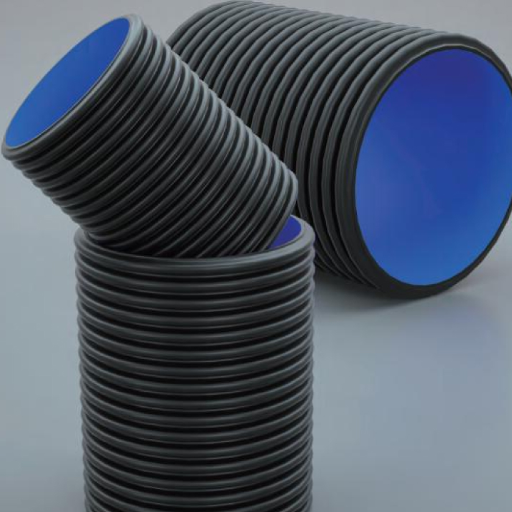
Steps for Pipe Installation
- Site Preparation: I ensure the trench is excavated to the required dimensions and that the base is uniform and well-compacted. The trench width should allow for proper placement and compaction of the backfill material. Depending on the qualities of the soil surrounding the pipe, the collar may also be required to be made of concrete.
- Bedding Material: I use granular material as bedding to provide a stable base for the pipe. Lodged in place by encasing pipe, it rests on the bottom of the trench or other supporting structures. The typical depth ranges between 4 to 6 inches, depending on the pipe’s diameter.
- Pipe Placement: I position the HDPE double wall pipe carefully in the trench, ensuring it is aligned seamlessly and that the bell and spigot connections fit tightly. For a leakage-proof installation, I make sure that the pipes are straightened against the soil. Loosened soil along with cement is used as a pour back to ensure that the pipes do not get displaced.
- Jointing Process: Using standard jointing methods such as bell-and-spigot with a gasket or welded joints, I confirm there is no deformation or gaps in the pipe connections. Heavy-duty screws with a rubber washer are also an ideal solution to prevent loss of pressure. Proper jointing is crucial for structural integrity and preventing infiltration or exfiltration.
- Initial Backfill: I utilize granular materials for initial backfilling up to 12 inches above the pipe crown. The material is compacted evenly on both sides of the pipe to prevent displacement and maintain stability. The finer material is hand-placed to not disturb the spreading soil.
- Final Backfill: I fill the remaining trench with suitable backfill material while avoiding large rocks or debris that could damage the pipe. Compaction is conducted in layers to achieve optimal soil density. After taking the measurements using the shovel, I place the material and repeat the last step to ensure that all soil is thoroughly conditioned.
- Examination and Analysis: I carry out visual checks as well as inspection under pressure, to ensure correct assembly methods are adhered to, and any deviations during alignment, joints, or pipe fracturing are looked after. Particular pressure values are relative to particular project needs and pipe specifications.
Following these procedures, together with associated technical such as bedding and backfill depths, joint types, etc., makes the process sensitive and facilitates the construction to be of high quality and within the required standards and regulations.
Requirements for Proper Joint Installation
Accuracy of Alignment: All joints are to be aligned appropriately to avoid excessive stress or leaks, which in turn requires checking that the pipe sections are within the manufacturer’s tolerable limits.
- Type of Joints and Compatibility: The selected joint type (push-fit, mechanical, welded joints, etc.) must be compatible with the pipe material and its intended use. For instance, elastomeric seal-type joints necessitate a material and ASTM or ISO compliance check.
- Lubrication: Approved lubricant application is crucial, where appropriate, to lower friction during assembly and also to prevent damage to edges and seals, while for some types of joints, it might be required.
- Insertion: Each pipe joint is set to the correct mark or depth as prescribed by the manufacturers. This is vital to adequately secure the joint for movement of the pipes thermally.
- Support and Bedding: Joint movement is prevented by ensuring that the pipe’s weight is evenly supported along its length. I further verify that the bedding material used is to the project specifications to enhance stability.
- Evaluation of Sealing Integrity: After the assembling process, I perform hydrostatic or pneumatic pressure tests depending on the requirements of the project. For instance, a common standard for locating any leakages or deformation captures is a pressure test at 1.5 times the operating pressure.
By correcting these guidelines with accuracy and following the technical documentation, I have been able to continuously achieve satisfactory joint installations in terms of functionality and compliance.
What Are the Key Applications of HDPE Double Wall Pipe?
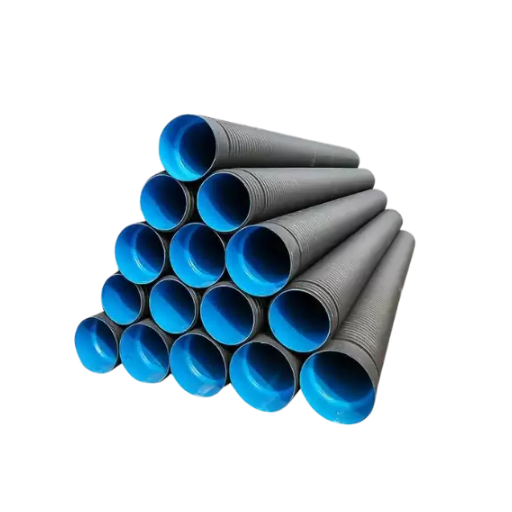
Use in Drainage Systems
The use of HDPE double-wall pipes in drainage systems is common because of their ability to withstand harsh environmental and chemical conditions. Furthermore, the pipes are remarkably durable, have high flow capacity, and are extremely effective in the management of drainage, stormwater, sewage, and industrial waste.
- High Flow Efficiency: Energy consumption during fluid conveyance is reduced with the help of a smooth inner wall which gives Manning’s coefficient of a low 0.009.
- Load-Bearing Capacity: There is excellent structural integrity that meets the ASTM F2306 standards for external load resistance because of the corrugated outer wall.
- Chemical Resistance: These pipes are highly effective for industrial applications due to the wide range of corrosive substances they can resist.
- Longevity: Under normal circumstances, these pipes can last over 50 years which makes them incredibly cost effective.
- Lightweight and Flexible: This feature allows for easy transportation and implementation which minimizes labor expense, especially over a broad range of landscapes.
With all these characteristics combined, I was able to incorporate HDPE double-wall pipes in drainage systems rationally and ensure the engineering prowess for the projects was met.
Chemical and Industrial Applications
The critical features of matter and the toughness of high-density polyethylene double-wall pipes bestow them with great utility in their application in the chemical and industrial sectors.
- Chemical Resistance: The range of polymers such as polyethylene provides a durability of 180 degrees to -180 degrees Celsius and is pliable for over 900 degrees centigrade making it the most ideal for chemical transport. As an example extreme pH of one to fourteen is no match for these pipes, further proving their durability in corrosive compounds.
- Thermal Stability: These pipes will maintain physical reliability under wide temperature heterogeneity of at least -40 degrees to 140 degrees Fahrenheit rendering them useful even in extremely tough climatic and thermal changes.
- High Abrasion Resistance: The polythene pipes will outlast 90% of the abrasive environment as screws, slurries, and granulated compounds are no match for the impact-resistant high-density durable polythene.
- Non-Toxic and Safe Design: Making these pipes non-reactive not only ensures the transportation of various chemicals through these pipes without any destruction to the chemical compounds but also serves to keep important industries free and able to function without the worry of cross-contamination.
With the above-mentioned characteristics together, the HDPE double-wall pipes have emerged as the pipes of choice for advanced chemical and industrial systems where sustainability and engineering compliance are required.
How Does HDPE Double Wall Pipe Compare to Other Pipe Systems?
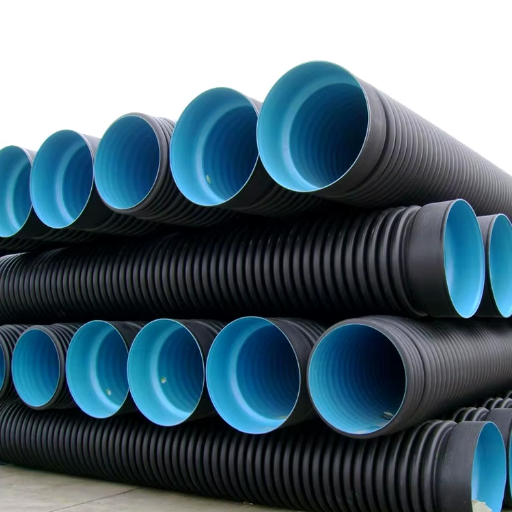
Compared with Traditional Pipe Materials
Compared to standard pipe materials like concrete, steel, or PVC, HDPE double-wall pipes stand out in various key areas:
- Weight and Installation: The weight of HDPE double-wall pipes drastically lowers than that of concrete and steel pipes. This results in lower transportation and installation costs. As an example, an HDPE double-wall pipe of 100 mm diameter weighs around 2 kg/m, as opposed to a steel pipe of the same diameter which weighs anywhere between 10 to 12 kg/m. A steel HDPE pipe is much more hassle-free in terms of transportation and deployment.
- Durability and Longevity: HDPE pipes retain their commendable chemical and weather resistance. Other pipes made of steel or concrete do not perform as well. HDPE pipes can last over 50 years without major deterioration during normal operating conditions.
- Hydraulic Efficiency: Compared to concrete or steel pipes, HDPE double-wall pipes have better flow rates due to their inner smooth surface. The inner surface has Manning’s roughness coefficient as low as 0.009. This increased efficiency cuts down pumping energy requirements which in turn lowers operational costs.
- Resistance to Temperature: Steel and concrete pipes tend to lose mechanical integrity when faced with extreme thermal conditions. Fortunately, HDPE can retain its structural integrity in a range of -40F to 140F and -40C to 60C, assuring security for a variety of applications.
- Environmental Impact: Steel and PVC production processes have a high carbon footprint which is environmentally unsound. On the other hand, when assessing the lifecycle of HDPE, its production emits lower greenhouse gases and is recyclable.
This makes HDPE double wall pipes industry-leading solutions for modern piping systems as they are economical, operationally efficient, and sustainable.
Benefits of Single Wall Pipe
Pipes featuring an HDPE inner layer benefit from an advanced construction which allows for superior engineering properties. These advantages include:
- Structural Strength and Durability: The ribbed outer layer of double-wall pipes provides superior load-bearing capacity compared to the single-wall design. These structures also excel in particular segments that require installation while being heavily loaded, for example, under roads and underneath heavy infrastructural edifices.
- Enhanced Flow Performance: Retention of the smooth surface characteristic of inner HDPE single wall surfacing coupled with low friction coefficient results in significantly reduced flow resistance in comparison to single wall pipes. Therefore, satisfactory flow rates are supported in these structures for decreased pipe diameters.
- Improved Longevity: Because of the reinforced structure of double-wall pipes, they are less susceptible to deformation or damage, as in single-wall pipes. This ensures a prolonged operational lifespan and minimal maintenance needs under harsh conditions.
- Thermal and Chemical Resistance: The HDPE double wall pipes, just like single wall pipes, are resistant to low and high temperatures (-40°F to 140°F or -40°C to 60°C) and chemical corrosion. The added structural integrity of double-wall pipes ensures they perform better under demanding environmental conditions.
- Cost Efficiency in the Long-Term: The price of double-wall pipes is relatively higher than single-wall pipes; however, in the long term, these pipes cost less due to their service life, minimal maintenance, and overall durability.
If I were to summarize the rationale for using double-wall pipes over single-wall designs, I’d emphasize their superior structural strength, efficient hydraulics, and long-term reliability for demanding applications.
Reference sources
Frequently Asked Questions (FAQs)
Q: What is HDPE Dual Wall Pipe and how is it used in advanced drainage systems?
A: HDPE Dual Wall Pipe is a type of corrugated pipe made from high-density polyethylene, used in advanced drainage systems for its superior strength and durability. It is commonly used for applications such as culverts, stormwater systems, and underground conduit installations.
Q: How does a dual wall pipe improve fluid containment compared to single wall pipes?
A: A dual wall pipe improves fluid containment by providing a smooth interior wall that enhances flow efficiency while the corrugated exterior provides structural integrity. This design minimizes leaks and enhances the pipe’s performance in various soil conditions.
Q: What sizes are available for HDPE Dual Wall N-12 Pipes?
A: HDPE Dual Wall N-12 Pipes are available in a variety of sizes to suit different project requirements, ranging from small diameter pipes to larger options like 24 inches for extensive drainage systems. For specific sizes, please contact us or connect with us for more detailed information.
Q: Can HDPE Dual Wall Pipes be used in soil-tight applications?
A: Yes, HDPE Dual Wall Pipes are suitable for soil-tight applications. Their design ensures a secure fit between pipe sections, reducing the risk of soil infiltration and maintaining system integrity over time.
Q: How does the corrugated design of HDPE pipes benefit underground installations?
A: The corrugated design of HDPE pipes offers enhanced flexibility and strength, making them ideal for underground installations. It allows the pipes to withstand environmental pressures and soil movements without compromising performance.
Q: What are the advantages of using HDPE Corrugated Pipes over traditional materials like corrugated metal pipe (CMP) or RCP?
A: HDPE Corrugated Pipes provide superior corrosion resistance, lighter weight, and easier handling compared to traditional materials like corrugated metal pipe (CMP) or reinforced concrete pipe (RCP). They also provide superior hydraulic performance and long-term cost savings.
Q: Is it possible to get custom fabrication for HDPE Dual Wall Pipes?
A: Yes, custom fabrication options are available for HDPE Dual Wall Pipes to meet specific project needs. For more details on customization, please contact us or ask our experts.
Q: How can I connect with us to learn more about the versatility of HDPE Dual Wall Pipe Systems?
A: To learn more about HDPE Dual Wall Pipe Systems, you can connect with us through our website or contact us directly. Our team is ready to assist with any inquiries and provide detailed information on our products and solutions.



